 What does the coat of arms of Ukraine mean to the average citizen? Why is the coat of arms a trident, and not something else? What does such a sign mean when it appeared? Most of the population perceives it only as a golden symbol on a blue background, well, maybe they also see the word "will" in it. Unfortunately, this is where knowledge and understanding end, although the trident symbol conceals many meanings and knowledge.
What does the coat of arms of Ukraine mean to the average citizen? Why is the coat of arms a trident, and not something else? What does such a sign mean when it appeared? Most of the population perceives it only as a golden symbol on a blue background, well, maybe they also see the word "will" in it. Unfortunately, this is where knowledge and understanding end, although the trident symbol conceals many meanings and knowledge.
The first talks about the trident as a state emblem began in 1918, with the adoption by the Central Rada of its state symbol. Such a choice, the politicians of that time explained by the fact that the trident since the times of Kyivan Rus was considered a sign of power and continuity of the traditions of Ukrainian statehood. Although from the time of the collapse of Kyivan Rus until the beginning of the 20th century, this sign was used little. The trident symbol was found exclusively in the heraldry of family coats of arms, cities or in books. An example of this can be Cossack coats of arms, in which crosses or anchors were stylized as a trident.
 In general, the history of the Ukrainian trident begins with the ancient princely family of the Rurikovichs, under whom this symbol was minted on everything from money and seals to bricks from which temples were built. The first written mentions of the trident as a symbol of the prince are found in the Bulgarian chronicle of the 10th century, according to this source, the banners of the warriors of Prince Svyatoslav were with tridents. However, according to research, Svyatoslav's symbol was a little simpler and had only two prongs. Scientists express the opinion that it was a sign of the letter "C" with a slightly shifted tail to the center, which was identified with the word "tsar".
In general, the history of the Ukrainian trident begins with the ancient princely family of the Rurikovichs, under whom this symbol was minted on everything from money and seals to bricks from which temples were built. The first written mentions of the trident as a symbol of the prince are found in the Bulgarian chronicle of the 10th century, according to this source, the banners of the warriors of Prince Svyatoslav were with tridents. However, according to research, Svyatoslav's symbol was a little simpler and had only two prongs. Scientists express the opinion that it was a sign of the letter "C" with a slightly shifted tail to the center, which was identified with the word "tsar".
Svyatoslav's son, Prince Vladimir the Great, continued his father's tradition and improved his coat of arms by adding another prong to it, and after the baptism of Rus', he added a horizontal line to the middle to depict a cross. It was under Vladimir that the trident acquired its familiar appearance.
 However, the trident was present in the territory of modern Ukraine long before the above-mentioned events. According to archaeological finds, it was widely used by the Trypillian tribes in the 3rd – 4th centuries BC. In those ancient times, the trident was a sign of elders. Examples of the use of the trident symbol are found in archaeological finds in Podillia, in Olbia and many other interesting places. Later, after the Trypillians, the trident symbol was used by the Scythians, who considered themselves direct descendants of the Atlanteans. It is interesting that the first written mention of the trident in general is found in Plato's work "Timenus" and dates back to 360-350 BC. In it, Plato describes the Atlantean kings, who dressed in blue clothes decorated with a golden trident.
However, the trident was present in the territory of modern Ukraine long before the above-mentioned events. According to archaeological finds, it was widely used by the Trypillian tribes in the 3rd – 4th centuries BC. In those ancient times, the trident was a sign of elders. Examples of the use of the trident symbol are found in archaeological finds in Podillia, in Olbia and many other interesting places. Later, after the Trypillians, the trident symbol was used by the Scythians, who considered themselves direct descendants of the Atlanteans. It is interesting that the first written mention of the trident in general is found in Plato's work "Timenus" and dates back to 360-350 BC. In it, Plato describes the Atlantean kings, who dressed in blue clothes decorated with a golden trident.
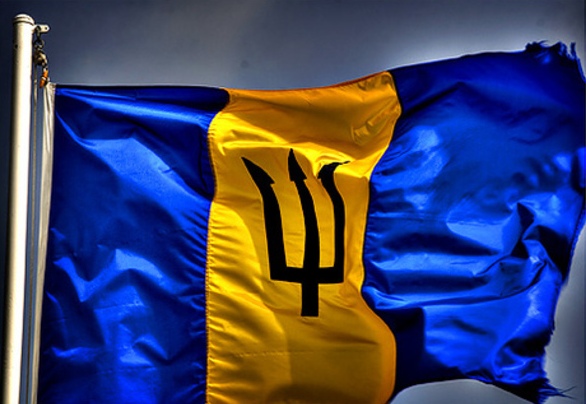 Although it may seem that the Ukrainian coat of arms with a trident is unique in the world, there are other states that use it as a state symbol, for example, Barbados. Interestingly, the flag of Barbados is also blue and yellow. In this country, the trident is interpreted as a trinity of the principles of government: for the people, of the people and with the people.
Although it may seem that the Ukrainian coat of arms with a trident is unique in the world, there are other states that use it as a state symbol, for example, Barbados. Interestingly, the flag of Barbados is also blue and yellow. In this country, the trident is interpreted as a trinity of the principles of government: for the people, of the people and with the people.
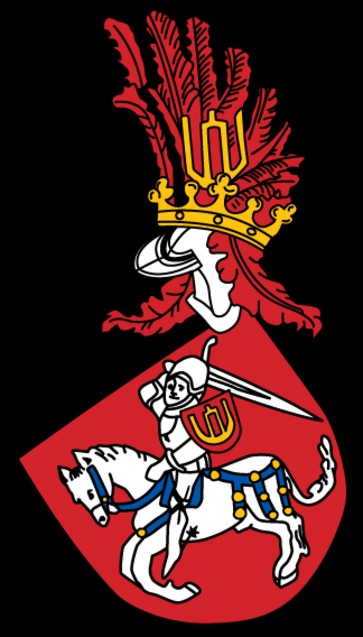 If you look closely at history, the principles of trinity are found in many cultures and countries. For example, the symbol of the Principality of Lithuania was Gediminas' Columns or Gediminas' Pillars. It would seem that the three columns have nothing to do with the trident, but if we interpret the deep original meaning, then what is important is only the combination of three forces or phenomena that form the basis of existence in the beliefs of our ancestors. These columns are still present on the Lithuanian coat of arms today. According to legend, such a symbol was brought to the principality from Rome by Prince Palenom, but since those ancient times, the similarity of the pillars with the Kiev Trident has been traced.
If you look closely at history, the principles of trinity are found in many cultures and countries. For example, the symbol of the Principality of Lithuania was Gediminas' Columns or Gediminas' Pillars. It would seem that the three columns have nothing to do with the trident, but if we interpret the deep original meaning, then what is important is only the combination of three forces or phenomena that form the basis of existence in the beliefs of our ancestors. These columns are still present on the Lithuanian coat of arms today. According to legend, such a symbol was brought to the principality from Rome by Prince Palenom, but since those ancient times, the similarity of the pillars with the Kiev Trident has been traced.
Various types and variations of tridents are common almost throughout Europe and Asia, as it has great sacred significance in the culture of many peoples. One of the most important meanings of the trident was in the culture of the Aryans, which is probably why echoes of the trinity can still be observed today on the family coats of arms of the descendants of the Aryans.
The symbolism of the trident is quite clearly traced in the culture of India, for example, there is the Temple of the Great Mother Goddess - Vaishnu Devi, where her bronze statue holds a trident in her right hand. The location of this temple is also very unusual, it is located on a unique mountain with three peaks, which is quite symbolically called "Trikuta". The trident in Indian culture is present in the images of the gods Vishnu and Shiva. According to Indian beliefs, the god Shiva uses his trident to create chaos, from which a new world is subsequently formed. For Hindus, the trident is a symbol of the unity of the protector, creator and destroyer. The state symbolism of this country also contains a trident, somewhat similar to the Ukrainian one, although local residents claim that this sign was brought to them by the Aryans.
 In almost every culture, there is a deity who was depicted with a trident, for example, in Greek mythology it was Poseidon, in Roman mythology it was Neptune, among the Scythians it was Tagimasad, and among the Slavs it was Vodyanyk and Perun.
In almost every culture, there is a deity who was depicted with a trident, for example, in Greek mythology it was Poseidon, in Roman mythology it was Neptune, among the Scythians it was Tagimasad, and among the Slavs it was Vodyanyk and Perun.
Interestingly, the largest image of a trident is in Peru. This image is carved into a rock and is called the Andean Candelabra, due to its resemblance to a candlestick with three candles, although the locals call it the "Three Crosses."
Few of our compatriots know that the Ukrainian trident is present on the emblems of the Italian army. According to the laws of this country, army units can add to their emblems the signs and symbols of the territories where they received military awards. So, during the Second World War, part of the army was sent to the USSR, namely to the territory of Ukraine, and although it was almost completely defeated, some of the soldiers and officers still returned to their homeland, later they formed a new military formation, which was allowed to add the Ukrainian trident to its emblems.
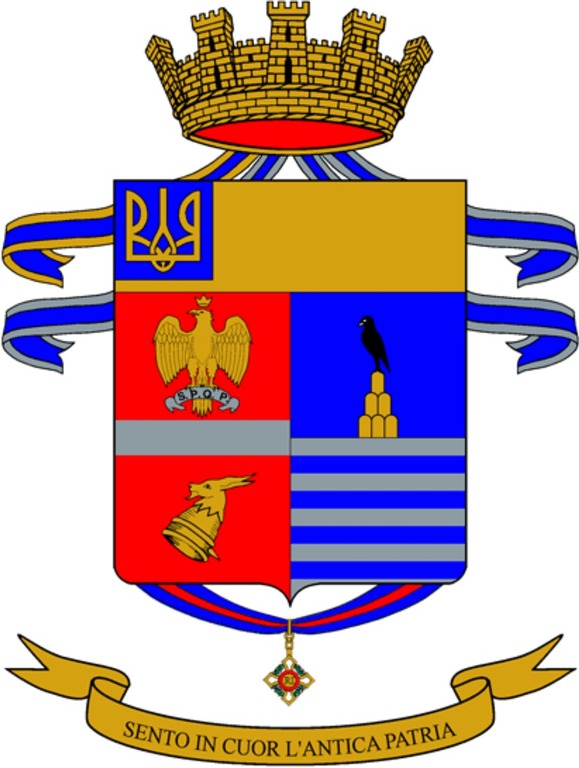 Interestingly, another concept, "trident," is widely known in the CIS countries, but it has little in common with the concept of "trident." This is because Ukrainians called a pitchfork a trident, while a trident has a deeper, symbolic, and sacred meaning.
Interestingly, another concept, "trident," is widely known in the CIS countries, but it has little in common with the concept of "trident." This is because Ukrainians called a pitchfork a trident, while a trident has a deeper, symbolic, and sacred meaning.
Today, there are a huge number of different theories of the meaning of the trident symbol, but, unfortunately, none of them gives a complete and exhaustive interpretation. For example, some scientists see in it specific features of inanimate and living objects, sometimes a scepter, sometimes a crown, sometimes a bird or even a flag. From a philosophical point of view, the trident symbolically reflects a certain phenomenon or concept. Thus, Vladimir's trident is interpreted as a symbol of power over three different worlds.
For some, the Ukrainian trident is a monogram from the words "Volya", "Vasilevs", "Volodymyr". Someone believes that this sign depicts two letters "V", and between them is a sign of royal power. However, such interpretations raise many questions, because the trident symbol has been known since ancient times, when these concepts were not even mentioned.
Many see in the trident an image of the number "3", which in ancient times was designated like the modern letter "Ш". This number in Egyptian culture has long personified the Divine order. For example, among the ancient Egyptians, the number three was associated with the combination of two elements, which led to the emergence of a new, third. According to Egyptian beliefs, the world consists of three interconnected levels: earthly, underground and heavenly, and any person has three important aspects: body, spirit and soul, and every phenomenon that occurs in the universe has three main stages - appearance, or emergence, development and destruction.
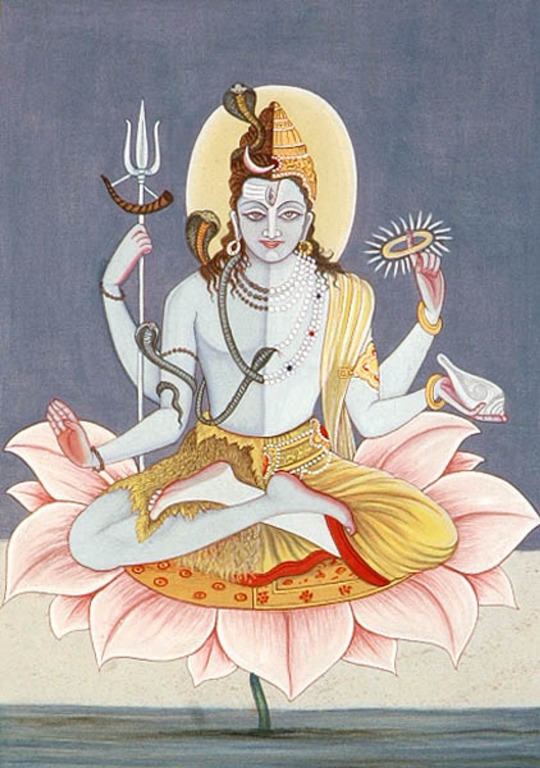 The main secret of the trident symbol lies precisely in the sacred number 3. The Trinity, or trinity, has accompanied humanity since the birth of the first civilizations. These are always three equal forces that come from the Absolute, which is inherent in every culture.
The main secret of the trident symbol lies precisely in the sacred number 3. The Trinity, or trinity, has accompanied humanity since the birth of the first civilizations. These are always three equal forces that come from the Absolute, which is inherent in every culture.
This trend is very well traced when studying the belief systems of ancient peoples and civilizations. For example, in ancient Greece there were three main deities - Zeus, Poseidon and Hades, in Hinduism - Vishnu, Shiva and Brahma, for the Egyptians it was Isis, Osiris and Horus, even if we turn to Christian teachings, the trinity is clearly traced, God the Father, God the Son and God the Spirit.
Despite the facts described above, one should not forget that the trident is a pagan symbol. And if we rely on pagan beliefs, then the small coat of arms used by the Kiev princes was a symbol of the Divine world, and the owner of such a coat of arms used it to proclaim himself the viceroy of God on earth.
 According to pagan beliefs, the trident represents the Kindred or Triglav, which personifies the trinity of the feminine principle - Makosh - the left part, the masculine - Dazhbog - the right part and the deity who takes care of life and death - Perun in the center. Oddly enough, the same principle is used in the construction of the calendar and Orthodox temples, churches. So the entrance is located only in the western part of the building, which symbolizes the embryo, death and autumn, parishioners and visitors enter facing the eastern part, which symbolizes the child, birth and spring, the northern part of the temples is considered feminine and personifies winter, and the southern part, respectively, masculine - summer.
According to pagan beliefs, the trident represents the Kindred or Triglav, which personifies the trinity of the feminine principle - Makosh - the left part, the masculine - Dazhbog - the right part and the deity who takes care of life and death - Perun in the center. Oddly enough, the same principle is used in the construction of the calendar and Orthodox temples, churches. So the entrance is located only in the western part of the building, which symbolizes the embryo, death and autumn, parishioners and visitors enter facing the eastern part, which symbolizes the child, birth and spring, the northern part of the temples is considered feminine and personifies winter, and the southern part, respectively, masculine - summer.
It is also quite likely that the trident could have been a runic symbol depicting a tree with three branches pointing uphill and symbolizing a positive meaning, while in contrast to it there was an inverted symbol that carried a negative meaning.
It is also widely believed that the trident is a reflection of the messenger of heavenly justice Rarog, or a falcon flying from a height of flight to the bottom. In most ancient cultures, this bird had great importance and was associated with victory over evil, a symbol of power, valor and strength. In the beliefs of our ancestors, the falcon occupied a place at the top of the world tree, and perhaps that is why the falcon falling to the bottom became the prototype of the coat of arms of the Rurik dynasty.
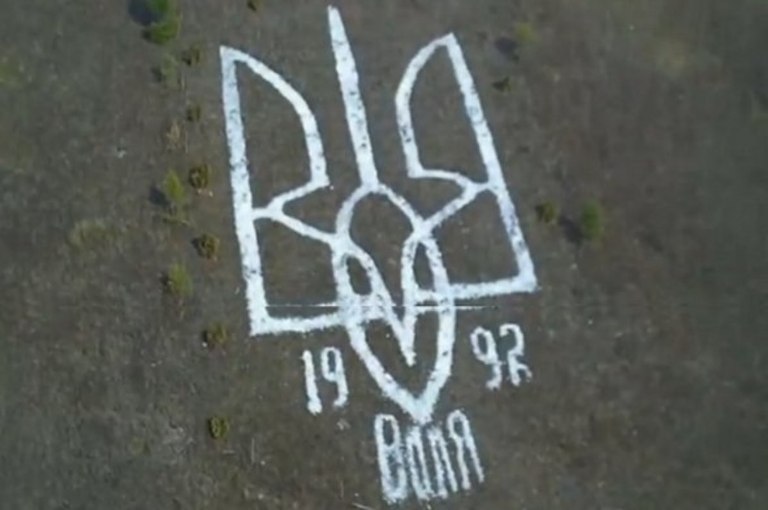 There are as many researchers as there are various hypotheses. Unfortunately, it is unlikely that anyone will be able to truly understand the meaning of the trident symbol, but it will never cease to attract and encourage the search for truth, knowledge, and understanding of the secrets of our ancestors.
There are as many researchers as there are various hypotheses. Unfortunately, it is unlikely that anyone will be able to truly understand the meaning of the trident symbol, but it will never cease to attract and encourage the search for truth, knowledge, and understanding of the secrets of our ancestors.
And finally, I would like to share an interesting fact: the largest trident in Ukraine was created in 1992, on a mountainside in Ivano-Frankivsk region, by former UPA soldier Anastasii Kozak. In this way, Anastasii honored the memory of his brothers who died at this place during the fierce battles between the rebels of Pylyp Orlyk's hundred and Bolshevik soldiers.

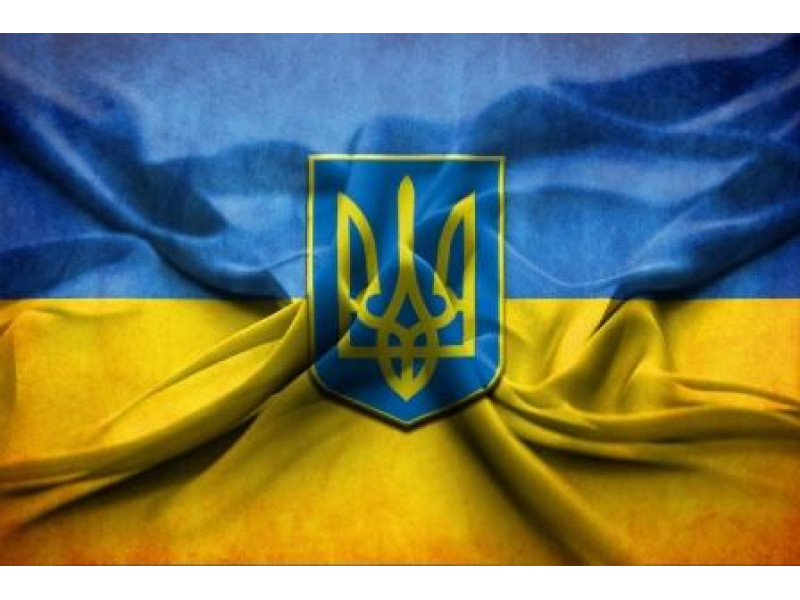
Write a comment